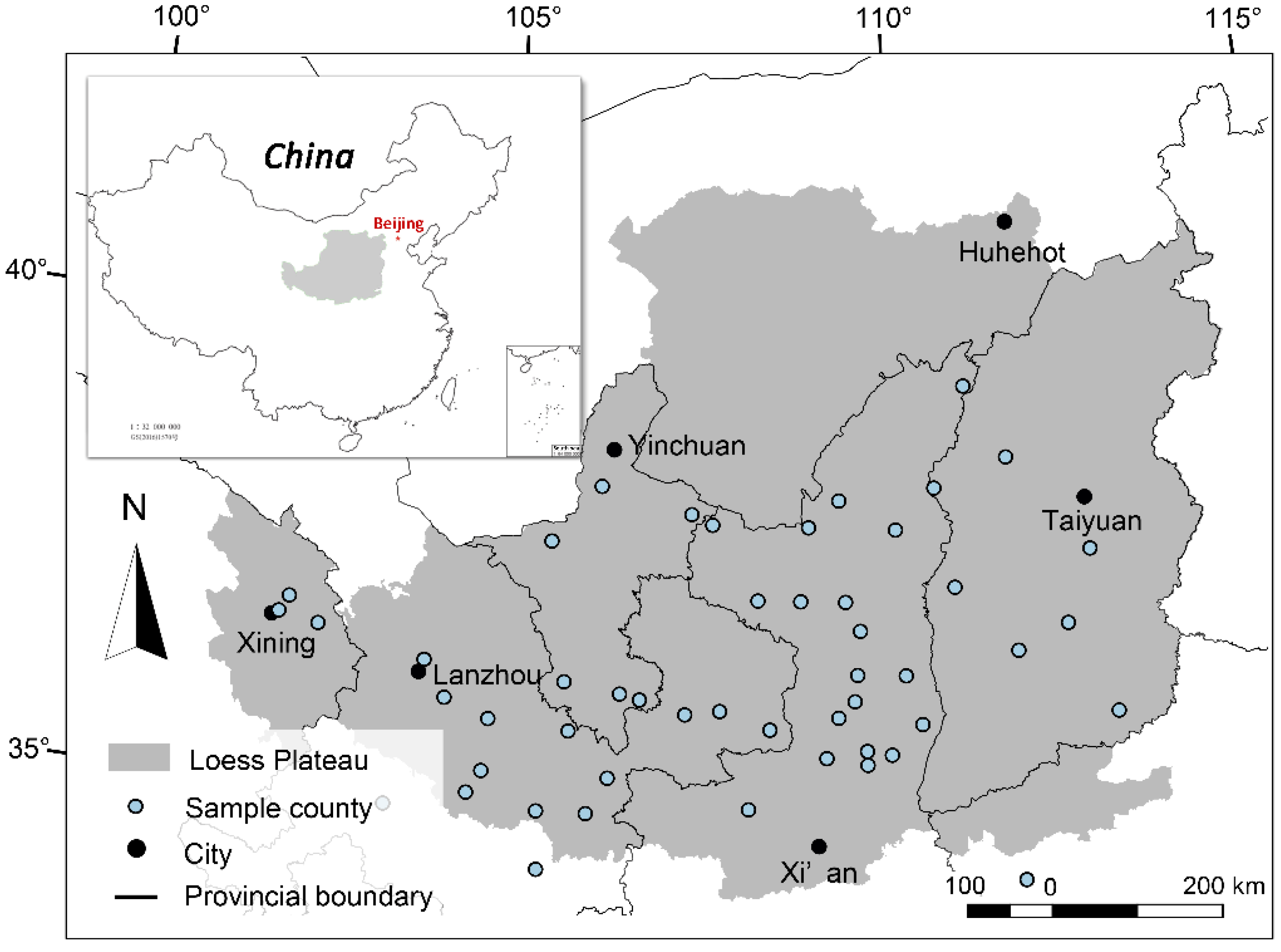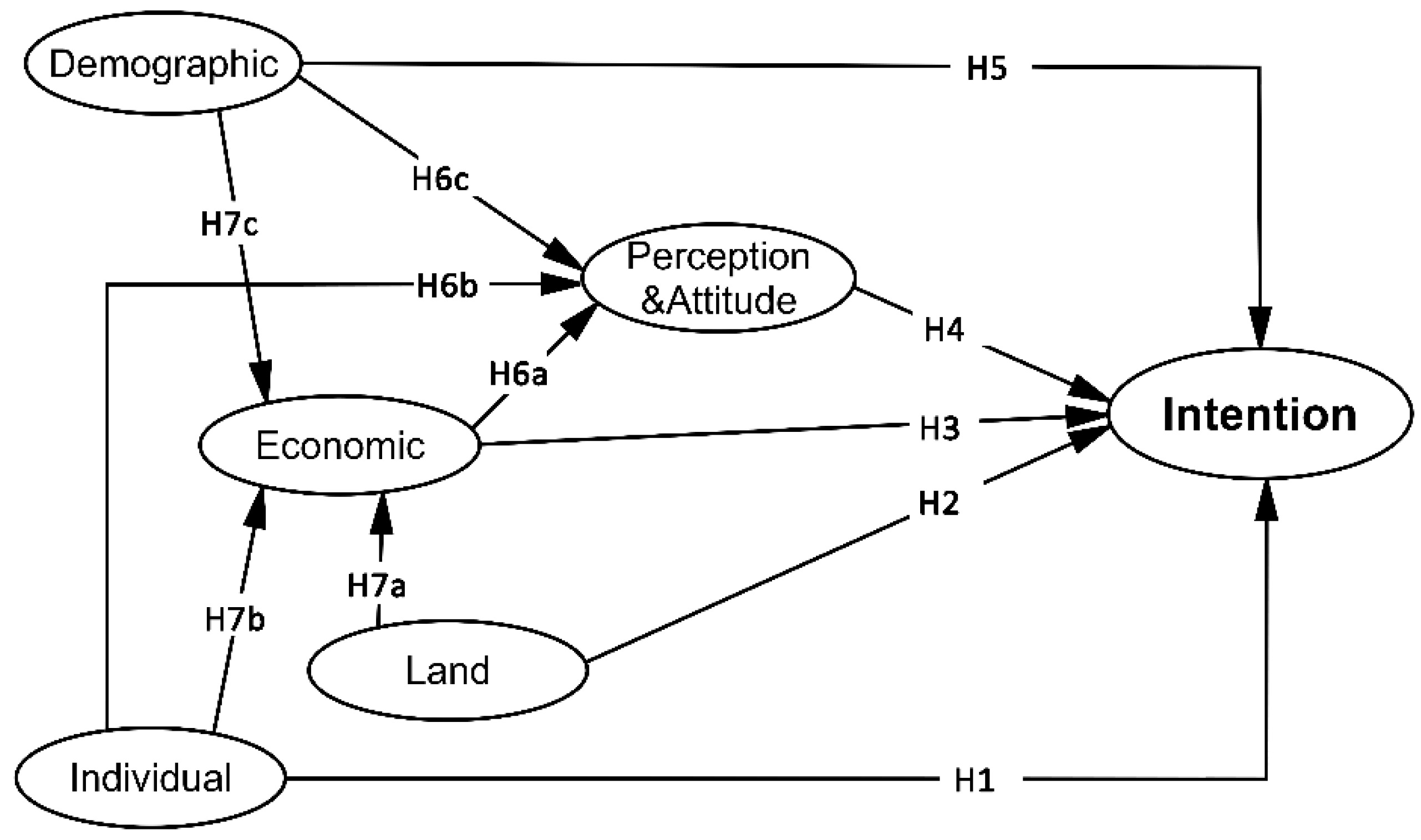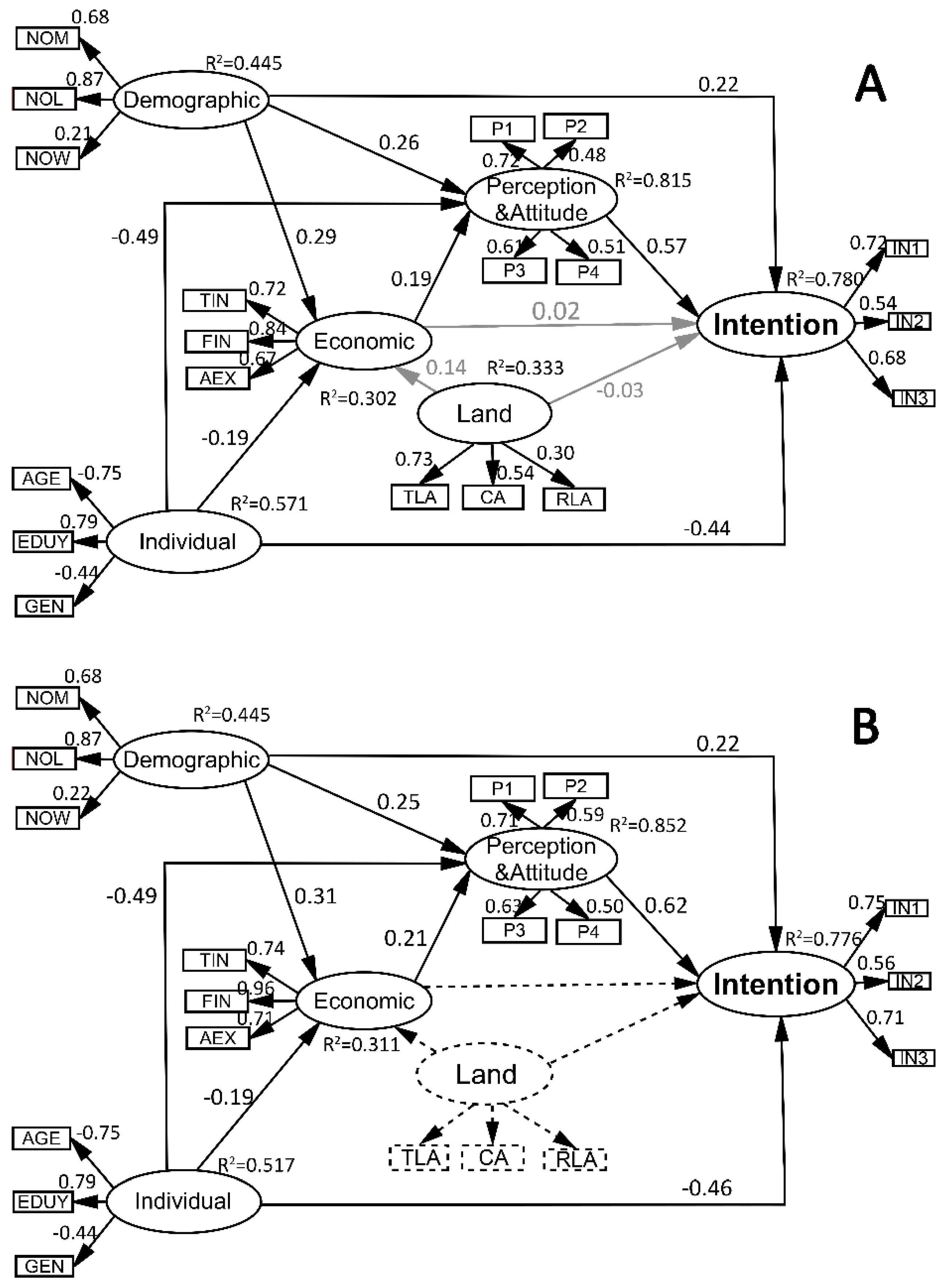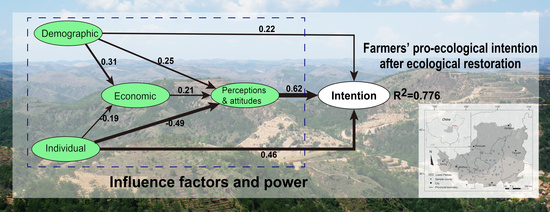Exploring Farmers’ Pro-Ecological Intentions after Ecological Rehabilitation in a Fragile Environment Area: A Structural Equation Modeling Approach
Abstract
:1. Introduction
2. Materials and Methods
2.1. Description of the Study Area
2.2. Survey and Question Design
2.3. The Initial and Hypothesis Development
2.4. Nondeterminacy and Bias
2.5. Statistical Analysis
3. Results
3.1. General Information of Sample Individuals and Households
3.2. Validity and Reliability Estimate, and the Exploratory Factor Analysis
3.3. Confirmatory FactorAnalysis and the Model Fit
3.4. Hypothesis Testing, and the Estimation of Direct and Indirect Effects
4. Discussion
4.1. Farmers’ Intention to Apply Pro-Ecological Behavior was Comprehensively Influenced by Various Factors
4.2. The Indirect Effect of Households’ EI and the Important Role of P and A on Farmers’ PEI
4.3. The External Factors Affecting Farmers’ PEI
5. Conclusions
Acknowledgments
Author Contributions
Conflicts of Interest
References
- Hooper, D.U.; Adair, E.C.; Cardinale, B.J.; Byrnes, J.E.K.; Hungate, B.A.; Matulich, K.L.; Gonzalez, A.; Duffy, J.E.; Gamfeldt, L.; O’Connor, M.I. A global synthesis reveals biodiversity loss as a major driver of ecosystem change. Nature 2012, 486, 105–108. [Google Scholar] [CrossRef] [PubMed]
- Foley, J.A.; DeFries, R.; Asner, G.P.; Barford, C.; Bonan, G.; Carpenter, S.R.; Chapin, F.S.; Coe, M.T.; Daily, G.C.; Gibbs, H.K.; et al. Global consequences of land use. Science 2005, 309, 570–574. [Google Scholar] [CrossRef] [PubMed]
- Salim, E.; Ullsten, O. Our Forests, Our Future; Cambridge University Press: Cambridge, UK, 1999. [Google Scholar]
- MacDougall, A.S.; McCann, K.S.; Gellner, G.; Turkington, R. Diversity loss with persistent human disturbance increases vulnerability to ecosystem collapse. Nature 2013, 494, 86–89. [Google Scholar] [CrossRef] [PubMed]
- Tacconi, L. Redefining payments for environmental services. Ecol. Econ. 2012, 73, 29–36. [Google Scholar] [CrossRef]
- Wunder, S.; Wertz-Kanounnikoff, S. Payments for ecosystem services: A new way of conserving biodiversity in forests. J. Sustain. For. 2009, 28, 576–596. [Google Scholar] [CrossRef]
- Deng, J.; Sun, P.; Zhao, F.; Han, X.; Yang, G.; Feng, Y.; Ren, G. Soil C, N, P and Its Stratification Ratio Affected by Artificial Vegetation in Subsoil, Loess Plateau China. PLoS ONE 2016, 11, e0151446. [Google Scholar] [CrossRef] [PubMed]
- Zhao, F.; Chen, S.; Han, X.; Yang, G.; Feng, Y.; Ren, G. Policy-guided nationwide ecological recovery: Soil carbon sequestration changes associated with the Grain-to-Green Program in China. Soil Sci. 2013, 178, 550–555. [Google Scholar] [CrossRef]
- Peng, H.; Cheng, G.; Xu, Z.; Yin, Y.; Xu, W. Social, economic, and ecological impacts of the “Grain for Green” project in China: A preliminary case in Zhangye, Northwest China. J. Environ. Manag. 2007, 85, 774–784. [Google Scholar] [CrossRef] [PubMed]
- Jellinek, S.; Rumpff, L.; Driscoll, D.A.; Parris, K.M.; Wintle, B.A. Modelling the benefits of habitat restoration in socio-ecological systems. Biol. Conserv. 2014, 169, 60–67. [Google Scholar] [CrossRef]
- Cao, S.; Xu, C.; Chen, L.; Wang, X. Attitudes of farmers in China’s northern Shaanxi Province towards the land-use changes required under the Grain for Green Project, and implications for the project’s success. Land Use Policy 2009, 26, 1182–1194. [Google Scholar] [CrossRef]
- Chen, X.D.; Lupi, F.; He, G.M.; Ouyang, Z.Y.; Liu, J.G. Factors affecting land reconversion plans following a payment for ecosystem service program. Biol. Conserv. 2009, 142, 1740–1747. [Google Scholar] [CrossRef]
- Roberts, M.J.; Lubowski, R.N. Enduring impacts of land retirement policies: Evidence from the Conservation Reserve Program. Land Econ. 2007, 83, 516–538. [Google Scholar] [CrossRef]
- Johnson, P.N.; Misra, S.K.; Ervin, R.T. A qualitative choice analysis of factors influencing post-CRP land use decisions. J. Agric. Appl. Econ. 1997, 29, 163–173. [Google Scholar] [CrossRef]
- Page, G.; Bellotti, B. Farmers value on-farm ecosystem services as important, but what are the impediments to participation in PES schemes? Sci. Total Environ. 2015, 515–516, 12–19. [Google Scholar] [CrossRef] [PubMed]
- Lise, W. Factors influencing people’s participation in forest management in India. Ecol. Econ. 2000, 34, 379–392. [Google Scholar] [CrossRef]
- Greiner, R. Motivations and attitudes influence farmers’ willingness to participate in biodiversity conservation contracts. Agric. Syst. 2015, 137, 154–165. [Google Scholar] [CrossRef]
- Yang, X.; Xu, J. Program sustainability and the determinants of farmers’ self-predicted post-program land use decisions: Evidence from the Sloping Land Conversion Program (SLCP) in China. Environ. Dev. Econ. 2014, 19, 30–47. [Google Scholar] [CrossRef]
- Dolisca, F.; Carter, D.R.; McDaniel, J.M.; Shannon, D.A.; Jolly, C.M. Factors influencing farmers’ participation in forestry management programs: A case study from Haiti. For. Ecol. Manag. 2006, 236, 324–331. [Google Scholar] [CrossRef]
- Mastrangelo, M.E.; Gavin, M.C.; Laterra, P.; Linklater, W.L.; Milfont, T.L. Psycho-Social Factors Influencing Forest Conservation Intentions on the Agricultural Frontier. Conserv. Lett. 2014, 7, 103–110. [Google Scholar] [CrossRef]
- Deng, J.; Sun, P.; Zhao, F.; Han, X.; Yang, G.; Feng, Y. Analysis of the ecological conservation behavior of farmers in payment for ecosystem service programs in eco-environmentally fragile areas using social psychology models. Sci. Total Environ. 2016, 550, 382–390. [Google Scholar] [CrossRef] [PubMed]
- Bo, N.; Ning, M.; Houqiang, Z.; Li, H. Empirical Analysis on the Influencing Factors of Farmer Households’ Willingness of Maintaining the Results of the Conversion of Cropland to Forestland Program in Western China. For. Econ. 2014, 4, 72–76. [Google Scholar]
- Li, H.; Yao, S.; Guo, Y. Analysis on Willingness of Farmers’s Strengthening Fruit of SLCP in Loess Plateau under New Subsidy. J. Huazhong Agric. Univ. (Soc. Sci. Ed.) 2011, 6, 76–82. [Google Scholar]
- Martínez-García, C.G.; Dorward, P.; Rehman, T. Factors influencing adoption of improved grassland management by small-scale dairy farmers in central Mexico and the implications for future research on smallholder adoption in developing countries. Livest. Sci. 2013, 152, 228–238. [Google Scholar] [CrossRef]
- Beedell, J.; Rehman, T. Using social-psychology models to understand farmers’ conservation behaviour. J. Rural Stud. 2000, 16, 117–127. [Google Scholar] [CrossRef]
- Yin, R.; Liu, C.; Zhao, M.; Yao, S.; Liu, H. The implementation and impacts of China’s largest payment for ecosystem services program as revealed by longitudinal household data. Land Use Policy 2014, 40, 45–55. [Google Scholar] [CrossRef]
- Liu, J.; Li, S.; Ouyang, Z.; Tam, C.; Chen, X. Ecological and socioeconomic effects of China’s policies for ecosystem services. Proc. Natl. Acad. Sci. USA 2008, 105, 9477–9482. [Google Scholar] [CrossRef] [PubMed]
- Fu, B.; Chen, L.; Ma, K.; Zhou, H.; Wang, J. The relationships between land use and soil conditions in the hilly area of the loess plateau in northern Shaanxi, China. CATENA 2000, 39, 69–78. [Google Scholar] [CrossRef]
- State Forestry Administration of China. China Forestry Statistical Yearbook; China Forestry Press: Beijing, China, 2012.
- Yang, W.Z.; Shao, M.A. Soil Water Research on the Loess Plateau; Science Press: Beijing, China, 2000. [Google Scholar]
- Liu, Z.; Shao, M.; Wang, Y. Effect of environmental factors on regional soil organic carbon stocks across the Loess Plateau region, China. Agric. Ecosyst. Environ. 2011, 142, 184–194. [Google Scholar] [CrossRef]
- National Development and Reform Commission, The Ministry of Water Resourcrs of the People’s Republic of China, Ministry of Agriculture of the People’s Republic of China, and State Forestry Administration of the People’s Republic of China. Comprehensive Management Planning Outline of Loess Plateau (2010–2030); National Development and Reform Commission, The Ministry of Water Resourcrs of the People’s Republic of China, Ministry of Agriculture of the People’s Republic of China, and State Forestry Administration of the People’s Republic of China: Beijing, China, 2010.
- National Bureau of Statistics of the People’s Republic of China. Statistical Bulletin of China’s National Economic and Social Development in 2014; National Bureau of Statistics of the People’s Republic of China: Beijing, China, 2014.
- Wang, S.; Zhi, L.; Zhang, Y. The Research Analysis about the Choose of Farmers’ Rehabilitation in the Later of Returning Land from Farming to Forestry—Cases Study of Anding District in Gansu Province. Probl. For. Econ. 2010, 30, 478–481. [Google Scholar]
- Cao, S.; Chen, L.; Yu, X. Grain for Green Project: Willingness evaluation of the farmers in northern Shaanxi Province of China. J. Appl. Ecol. 2009, 20, 426–434. [Google Scholar]
- Chen, X.; Lupi, F.; He, G.; Liu, J. Linking social norms to efficient conservation investment in payments for ecosystem services. Proc. Natl. Acad. Sci. USA 2009, 106, 11812–11817. [Google Scholar] [CrossRef] [PubMed]
- Ajzen, I. Theory of Planned Behavior; Sage: London, UK, 2011; Volume 1, pp. 438–459. [Google Scholar]
- Meijer, S.S.; Catacutan, D.; Sileshi, G.W.; Nieuwenhuis, M. Tree planting by smallholder farmers in Malawi: Using the theory of planned behaviour to examine the relationship between attitudes and behaviour. J. Environ. Psychol. 2015, 43, 1–12. [Google Scholar] [CrossRef]
- Oppenheim, A.N. Questionnaire Design, Interviewing and Attitude Measurement; Bloomsbury Publishing: London, UK, 2000. [Google Scholar]
- Borges, J.A.R.; Oude Lansink, A.G.J.M.; Marques Ribeiro, C.; Lutke, V. Understanding farmers’ intention to adopt improved natural grassland using the theory of planned behavior. Livest. Sci. 2014, 169, 163–174. [Google Scholar] [CrossRef]
- Kaiser, H. An index of factorial simplicity. Psychometrika 1974, 39, 31–36. [Google Scholar] [CrossRef]
- Bartlett, M.S. A note on the multiplying factors for various chi square approximations. Ann. Math. Stat. 1940, 11, 204–209. [Google Scholar]
- Poppenborg, P.; Koellner, T. Do attitudes toward ecosystem services determine agricultural land use practices? An analysis of farmers’ decision-making in a South Korean watershed. Land Use Policy 2013, 31, 422–429. [Google Scholar] [CrossRef]
- Burton, R.J.F. The influence of farmer demographic characteristics on environmental behaviour: A review. J. Environ. Manag. 2014, 135, 19–26. [Google Scholar] [CrossRef] [PubMed]
- Goldsmith, P.D.; Gunjal, K.; Ndarishikanye, B. Rural-urban migration and agricultural productivity: The case of Senegal. Agric. Econ. 2004, 31, 33–45. [Google Scholar]
- Price, J.C.; Leviston, Z. Predicting pro-environmental agricultural practices: The social, psychological and contextual influences on land management. J. Rural Stud. 2014, 34, 65–78. [Google Scholar] [CrossRef]
- Wauters, E.; Mathijs, E. An Investigation into the Socio-psychological Determinants of Farmers’ Conservation Decisions: Method and Implications for Policy, Extension and Research. J. Agric. Educ. Ext. 2012, 19, 53–72. [Google Scholar] [CrossRef]
- Shuifa, K. Empirical and Theory Research of Farmers Participate in the Returning Farmland to Forest Program; China Agriculture Press: Beijing, China, 2007. [Google Scholar]
- Vik, J.; McElwee, G. Diversification and the Entrepreneurial Motivations of Farmers in Norway*. J. Small Bus. Manag. 2011, 49, 390–410. [Google Scholar] [CrossRef] [Green Version]
- Cacho, O.J.; Milne, S.; Gonzalez, R.; Tacconi, L. Benefits and costs of deforestation by smallholders: Implications for forest conservation and climate policy. Ecol. Econ. 2014, 107, 321–332. [Google Scholar] [CrossRef]
- Kang, R.; Yan, X.X.; Wang, L.Q. Study on the Farmer’s Willingness to Maintain the Results from Returning the Grain Land to the Forestry and the Affecting Factors—A case Study in Datong County, Shanxi Province. For. Econ. 2014, 3. [Google Scholar] [CrossRef]
- Cao, S.; Chen, L.; Liu, Z. An investigation of Chinese attitudes toward the environment: Case study using the Grain for Green Project. Ambio 2009, 38, 55–64. [Google Scholar] [CrossRef] [PubMed]



| Constructs (Abbreviation) | Variables | Description of Variables and Questions (Unit) | Ranges |
|---|---|---|---|
| Individual properties (IP) | AGE | Age of respondent (year) | 15–78 |
| EDUY | Education years of respondent (year) | 0–16 | |
| GEN | Gender of respondent | Female (0)–Male (1) | |
| Demographic properties (DP) | NOM | Number of respondent’s family member (person) | 2–11 |
| NOL | Number of labor force in respondent’s family (person) | 0–8 | |
| NOW | Number of migrant workers in respondent’s family (person) | 0–7 | |
| Economic indexes (EI) | TIN | Total income in a year (USD) | $76.923–$77,779.811 |
| FIN | Farming income in a year (USD) | $0–$55,111.371 | |
| AEX | Agricultural expenditure in a year (USD) | $0–$42,740.523 | |
| SUB | Subsidies from ecological restoration program (USD) | $0–$3500 | |
| Land properties (LP) | TLA | Total land area, include cultivated land, and forest land (ha) | 0.10–10.600 |
| CA | Cultivated land area (ha) | 0–8.000 | |
| RLA | Ecological restoration land of household (ha) | 0–5.33 | |
| Perception and attitudes (P&A) | P1 | The income of my family was increased benefit from the achievements and subsidy of ecological restoration program. | “strongly disagree” (1)–“strongly agree” (5) |
| P2 | I have sufficient resources (labor, time and financial resources) to apply pro-ecological behavior. | ||
| P3 | Our living environment was improved because of the ecological benefits from ecological governance. | ||
| P4 | I support the behaviors of protecting ecology. | ||
| Pro-ecological intention (PEI) | IN1 | I was willing to apply pro-ecological behavior. | “very reluctant” (1)–“very glad” (5) |
| IN2 | I was willing to publicize and promote pro-ecological behavior to people around me | ||
| IN3 | I was willing to learn new knowledge and technology about protecting ecosystems. |
| Index (Unit) | Mean | Standard Deviation |
|---|---|---|
| Age (year) | 45.15 | 12.50 |
| Education level (year) | 5.63 | 4.77 |
| Gender (0 = female; 1 = male) | 0.65 | 0.48 |
| Number of laborers in a family (person) | 2.90 | 1.32 |
| Total income (USD) | $6665.22 | $5801.05 |
| % farming income from total income | 33.79 | 36.60 |
| % governmental subsidy from total income | 8.32 | 10.52 |
| Total land area (ha) | 1.47 | 1.14 |
| % ecological restoration land from total land | 40.78 | 32.22 |
| % farmers’ willing to apply pro-ecological behavior | 28.74 | -- |
| Farmers’ support degree of protecting ecology (1 = not support; 5 = support) | 3.42 | 1.21 |
| Variables | Factor 1 Loading | Factor 2 Loading | Factor 3 Loading | Factor 4 Loading | Factor 5 Loading | Cronbach’s Alpha Value |
|---|---|---|---|---|---|---|
| Individual properties | 0.598 | |||||
| AGE | −0.173 | −0.821 | −0.041 | 0.025 | −0.003 | |
| EDUY | 0.23 | 0.761 | 0.118 | 0.03 | 0.059 | |
| GEN | 0.173 | 0.565 | 0.077 | 0.111 | −0.007 | |
| Demographic properties | 0.695 | |||||
| NOM | 0.099 | 0.145 | 0.133 | 0.822 | 0.038 | |
| NOL | 0.181 | 0.249 | 0.198 | 0.745 | 0.011 | |
| NOW | 0.008 | −0.337 | −0.114 | 0.621 | 0.075 | |
| Economic index | 0.823 | |||||
| TIN | 0.192 | 0.137 | 0.779 | 0.226 | −0.024 | |
| FIN | 0.113 | 0.067 | 0.921 | 0.035 | 0.07 | |
| AEX | 0.066 | 0.061 | 0.826 | −0.014 | 0.148 | |
| Land properties | 0.739 | |||||
| TLA | 0.028 | 0.044 | 0.095 | 0.031 | 0.948 | |
| CA | −0.043 | 0.25 | 0.017 | 0.037 | 0.801 | |
| RLA | 0.094 | −0.254 | 0.086 | 0.047 | 0.673 | |
| Perception & attitude | 0.726 | |||||
| P1 | 0.637 | 0.247 | 0.212 | 0.183 | 0.099 | |
| P2 | 0.714 | 0.158 | 0.016 | 0.109 | 0.043 | |
| P3 | 0.727 | 0.148 | 0.187 | 0.09 | 0.01 | |
| P4 | 0.741 | 0.104 | 0.028 | −0.037 | −0.033 | |
| Variance contribution rate | 28.85% | 14.90% | 9.47% | 7.73% | 2.30% | |
| Accumulated variance contribution rate | 63.260% | |||||
| Overall Cronbach’s alpha value | 0.708 | |||||
| Kaiser-Meyer-Olkin | 0.717 | |||||
| Bartlett’s test of sphericity | <0.001 | |||||
| Fit Index | Index | Recommended Levels | Estimate Values for Initial Model | Estimate Values for Final Model |
|---|---|---|---|---|
| Absolute fit index | χ2/df | <5 | 7.12 | 4.868 |
| RMSEA | <0.10 | 0.081 | 0.072 | |
| GFI | >0.9 | 0.890 | 0.932 | |
| Incremental fit indices | NFI | >0.9 | 0.829 | 0.898 |
| CFI | 0 (no fit) to 1 (perfect fit) | 0.848 | 0.914 | |
| Parsimony fit indices | PGFI | >0.5 | 0.479 | 0.658 |
| PNFI | >0.5 | 0.593 | 0.719 |
| Hypothesis | Effect Pathway | Estimate | S.E. | C.R. | p | Test Result | |
|---|---|---|---|---|---|---|---|
| Direct effect | H1 | IP→PEI | −0.460 | 0.069 | −10.744 | <0.01 | Validated |
| H2 * | LP→PEI | −0.03 | 49.175 | 2.429 | 0.052 | Rejected | |
| H3 * | EI→PEI | 0.06 | 0.003 | 1.663 | 0.096 | Rejected | |
| H4 | P&A→PEI | 0.624 | 0.060 | 12.092 | <0.01 | Validated | |
| H5 | DP→PEI | 0.215 | 0.067 | 6.093 | <0.01 | Validated | |
| H6a | EI→P&A | 0.207 | 0.143 | 5.520 | <0.01 | Validated | |
| H6b | IP→P&A | −0.487 | 0.062 | −10.913 | <0.01 | Validated | |
| H6c | DP→P&A | 0.311 | 0.071 | 7.127 | <0.01 | Validated | |
| H7a * | LP→EI | 0.045 | 49.175 | 2.429 | 0.055 | Rejected | |
| H7b | IP→EI | −0.190 | 0.014 | −4.972 | <0.01 | Validated | |
| H7c | DP→EI | 0.251 | 0.017 | 6.268 | <0.01 | Validated | |
| Indirect effect | EI→P&A→PEI | 0.129 | -- | -- | <0.01 | ||
| IP→EI→P&A→PEI IP→P&A→PEI | −0.328 | -- | -- | <0.01 | |||
| DP→EI→P&A→PEI DP→P&A→PEI | 0.227 | -- | -- | <0.01 | |||
| IP→EI→P&A | −0.039 | -- | -- | <0.01 | |||
| DP→EI→P&A | 0.052 | -- | -- | <0.01 |
© 2017 by the authors. Licensee MDPI, Basel, Switzerland. This article is an open access article distributed under the terms and conditions of the Creative Commons Attribution (CC BY) license (http://creativecommons.org/licenses/by/4.0/).
Share and Cite
Deng, J.; Hao, W.; Zhang, W.; Han, X.; Li, K.; Feng, Y.; Yang, G. Exploring Farmers’ Pro-Ecological Intentions after Ecological Rehabilitation in a Fragile Environment Area: A Structural Equation Modeling Approach. Sustainability 2018, 10, 29. https://doi.org/10.3390/su10010029
Deng J, Hao W, Zhang W, Han X, Li K, Feng Y, Yang G. Exploring Farmers’ Pro-Ecological Intentions after Ecological Rehabilitation in a Fragile Environment Area: A Structural Equation Modeling Approach. Sustainability. 2018; 10(1):29. https://doi.org/10.3390/su10010029
Chicago/Turabian StyleDeng, Jian, Wenhui Hao, Wei Zhang, Xinhui Han, Kaiyuan Li, Yongzhong Feng, and Gaihe Yang. 2018. "Exploring Farmers’ Pro-Ecological Intentions after Ecological Rehabilitation in a Fragile Environment Area: A Structural Equation Modeling Approach" Sustainability 10, no. 1: 29. https://doi.org/10.3390/su10010029





